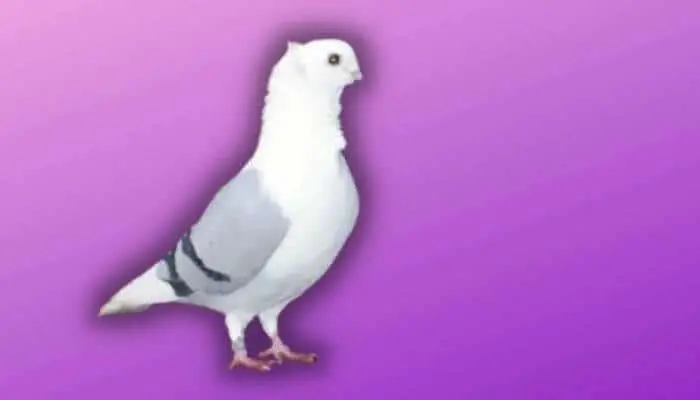Known by the Germans as the Altdeutsches Mövchen, the Old German Owl Pigeon is a domestic fancy pigeon breed that originally came from Germany and is the starting model for the short-faced German Shield Owls.

Because its markings and colors gave it some resemblance to the Silver Gull, it was first known in Germany as the Little Gull (the Mövchen).
Though this bird has spread around the world, it is still most common in Germany.
Old German Owl Pigeon Origins
In 1870, Oriental Frills and Anatolian Owls were imported into Germany, they are likely to have been the starting point for the variations we now see today in Old German Owl Pigeons.
The Old German Owl pigeon began as the Little Gull, and was then formally recognized in 1956 in Germany, though its official classification was not adopted around Europe until 1960.
The National Pigeon Association of America adopted this bird’s standard in 1999, with the idea that there are many color variants of the Old German Owl Pigeon breed.
Old German Owl Pigeon Appearance
The Old German Owl Pigeon has a full crest above its head, but it is small, and closing with rosettes.
These birds have bright and lively bull eyes that are relatively larger than in other pigeons.
Their cere is delicate and light, and the head and neck has a proud arched manner.
The Old German Owl Pigeon has a short neck that appears stocky, which slants in a backwards and upright position to create its proud appearance.
Your Old German Owl Pigeon will have a well-developed frill and a slight dewlap.
Its beak will be broad and of medium length and will be a light flesh color.
This colour creates a sort-of obtuse angle with the bird’s head. It also has a wattle that is undeveloped and small.
The Old German Owl Pigeon will have a broad breast that is held forwards in a prominent manner and is well-rounded. Its wings cover its back and rest neatly on its tail and lie very close to the body, and its wings are relatively strong.
The tail of this bird has tightly packed feathers and is very short. Its legs are short, and you cannot see its shanks very well.
Their broad shoulders become narrower as they approach the tail and slope downwards.
This bird does not have feathered toes or feet, and the feathers of this bird are tight and will lie very tightly against the body.
There are a variety of colours for the Old German Owl Pigeon, but the most common are red, brown, white, bars in black, checks, spread, recessive red, blue, brown and ash red.
You will also see dilutes of the bird’s base colours.
The average Old German Owl Pigeon will be around 25cm high, and mature pigeons weigh between 280 and 360 grams.
They Are Exciting Fliers
These birds are not going to win any aerial acrobatics awards, but younger birds will experiment with dips, rolls, and twirling circles when they are let out to fly around.
Their excited young exuberance often pushes them to do more than the average flap around the yard. They are very good fliers, which helps keep predators at a distance.
Also Read:
The Chinese Owl Pigeon Breed Guide
Italian Owl Pigeon Breed Guide
Aachen Lacquer Shield Owl Pigeon
Breeding The Old German Owl Pigeon
Getting these pigeons to breed is just as easy as most other common pigeons.
The Old German Owl Pigeon does make a very good parent, which is why some people also use them as foster parents.
There are many varieties, but breeding desired traits is not overly difficult.
You may get a few surprises when you breed a certain darker color set of birds and receive one or two red offspring.
Nevertheless, if you are pretty sure what you want, then pair up the correct birds and you will often get exactly what you expect.
Do not breed them more than three times per year because it causes stress in the birds, and that also includes making them foster parents.
Try not to make them foster parents more than three times per year because they will run themselves ragged trying to raise the chicks.
Old German Owl Pigeon Character
These are pretty intelligent birds, which is why their personalities can seem rather diverse.
Some say that they are very shy and very quiet, and others say that they have a calm and tame attitude with a good temperament.
With these birds, a good trick is to put them with other birds who are also tame, as they will often copy the behavior of other birds.
They are easy-going birds in most cases that are best for ornamental purposes and for shows.
If you intend to keep them as pets, then getting more than one will help normalize them more quickly, and as mentioned, keep them with other tame birds because if they see other birds panicking or becoming nervous around you, then they too will act panicky and nervous.
Resources:
